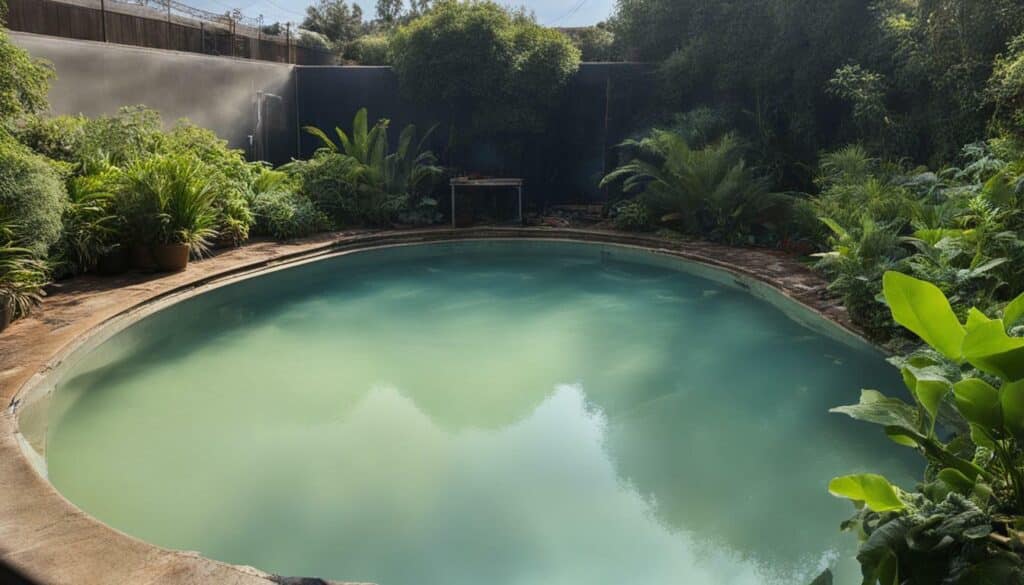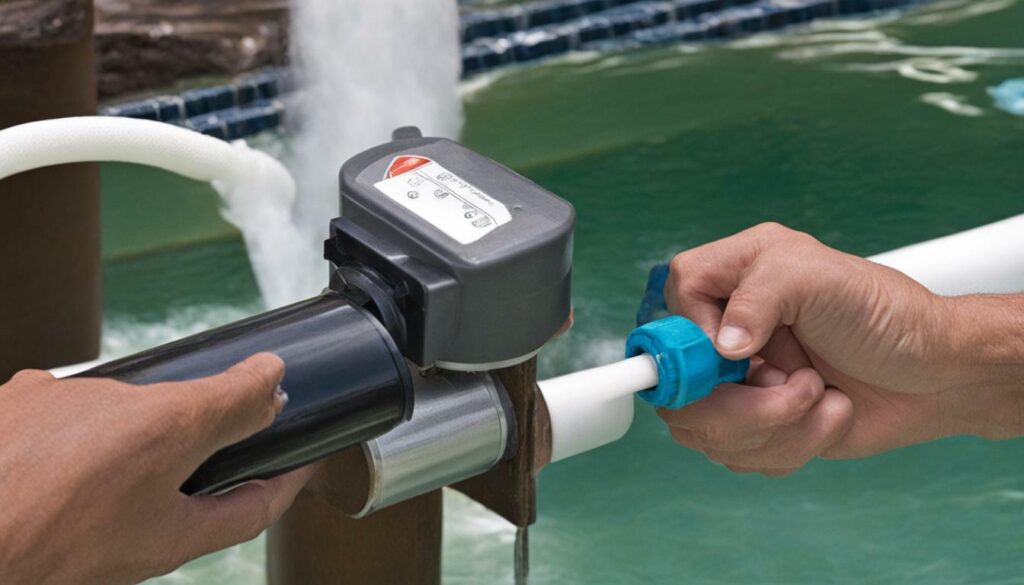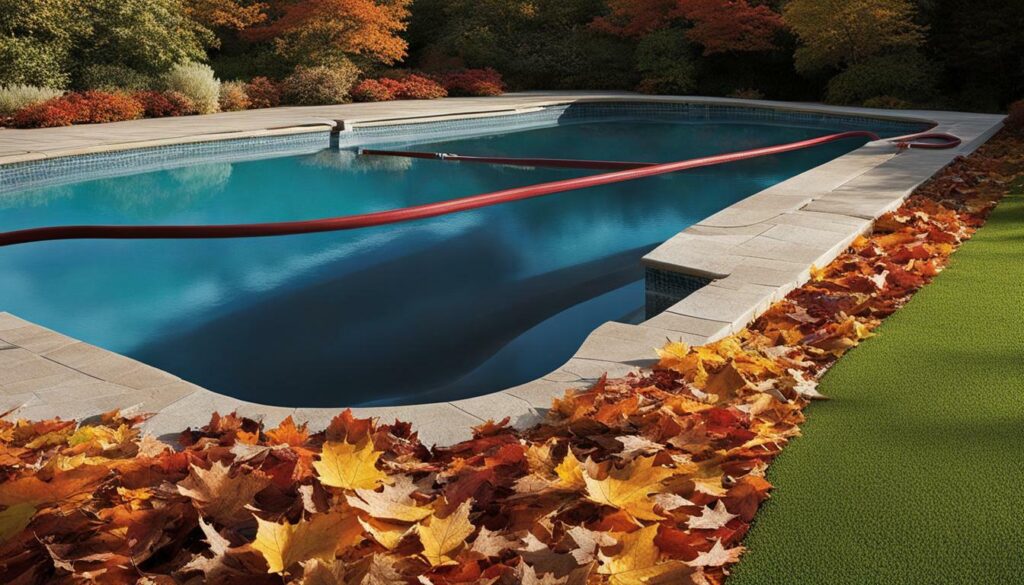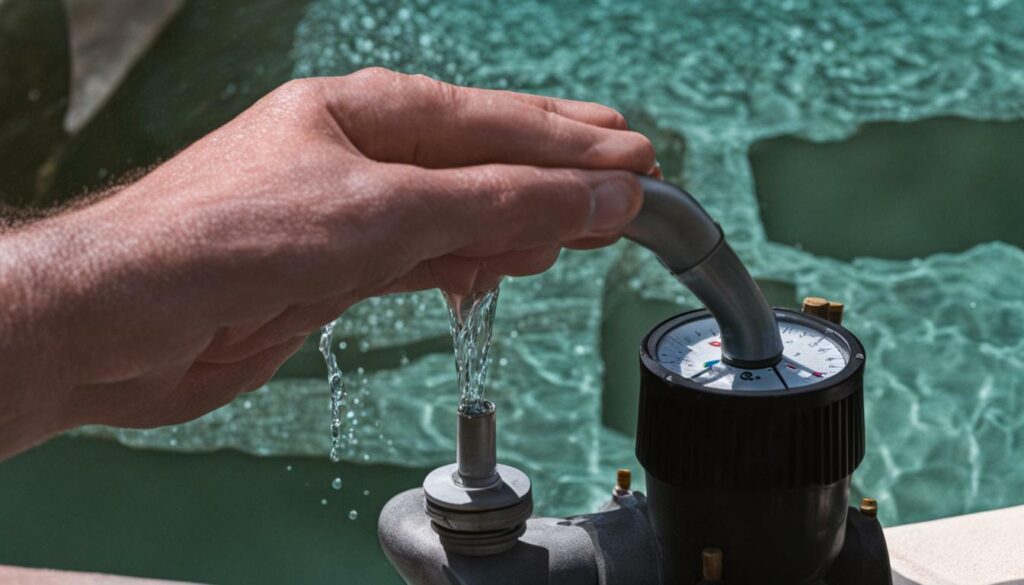
If you own a pool, one of the essential tasks you’ll need to perform is turning on the pool pump. A pool pump is responsible for circulating pool water, which helps keep the water clean and healthy. While the process of turning on a pool pump may seem daunting, it’s actually a straightforward task that you can easily perform on your own. In this section, we’ll provide step-by-step instructions for properly activating your pool pump and ensuring it starts up correctly.
- Knowing how to turn on a pool pump is essential for proper pool maintenance.
- Activating the pool pump requires a few simple steps, but it’s important to follow them correctly to ensure proper operation.
- Before starting the pool pump, be sure to check for any potential safety hazards or issues.
- Regular monitoring and maintenance can help prevent problems with your pool pump and ensure it operates efficiently.
- If you encounter any issues with your pool pump, troubleshooting tips can help identify and resolve common problems.
Understanding Your Pool Pump

Before learning how to turn on your pool pump, it’s important to have a basic understanding of its components and operating instructions. The pool pump is a vital part of the pool’s filtration system, responsible for circulating the water and removing debris.
The on/off switch of the pool pump is typically located on the motor housing or a nearby control panel. This switch controls the power supply to the pump and should always be turned off before performing any maintenance tasks or adjusting the pump’s settings.
The pool pump operates by pulling water from the pool, filtering it through the pool’s filtration system, and then returning it back to the pool. This circulation process is necessary for keeping the pool clean and clear of contaminants.
To operate the pool pump safely and efficiently, it’s crucial to refer to the manufacturer’s instructions and follow recommended maintenance schedules. Failing to do so can result in damage to the pump and potential safety hazards.
Checking Pool Safety Measures
Prior to starting your pool pump, it is crucial to ensure the safety of everyone around the pool. Pool safety should always be your priority, and following these simple steps can prevent any unwanted accidents. Take a few moments to check for any safety hazards or issues before activating your pool pump.
| Safety Checks | Action |
|---|---|
| Check for debris | Remove any debris, toys, or other objects that may have blown into the pool, as they can clog the pump or cause suction blockage. |
| Check the pool drain | Ensure that the pool drain covers are secure and in good condition. Broken or missing drain covers can cause entrapment or drowning. |
| Check the water level | Make sure the water level is above the skimmer. If it’s too low, the pump may suck in air, causing damage to the pump or filtration system. |
| Check the equipment pad | Ensure that the equipment pad is dry and clear of any debris. Wet electrical equipment can be dangerous and cause electrical shock. |
If you encounter any issues during the safety check or notice something that requires maintenance, refrain from activating the pool pump until the problem has been resolved. It’s crucial to keep a safe pool environment to avoid any potential accidents or harm.

Before turning on your pool pump, it’s essential to prepare it by performing routine maintenance tasks. By keeping up with regular maintenance, you can ensure your pool pump operates efficiently, prolong its lifespan, and prevent potential issues from arising.
Start by inspecting the pump for any leaks or visible damage. Ensure that all connections are securely fastened and tight. Check the pump’s strainer basket and remove any debris or leaves that may have accumulated. Clogged baskets can restrict water flow, leading to reduced pump performance.
Next, check the pump’s filter and clean or replace it if necessary. Dirty filters can cause the pump to work harder than it needs to, which can lead to premature wear and tear.
It’s also important to lubricate the pump’s O-rings and gaskets to prevent leaks and maintain a tight seal. Use a silicone-based lubricant for this task, and be sure to avoid petroleum-based products, which can damage the pump’s components.
| Tip: | Consider keeping a regular maintenance schedule for your pool pump to ensure it stays in optimal condition. This schedule may include tasks such as checking for leaks, cleaning the strainer basket, and replacing the filter as needed. |
|---|
By taking the time to prepare your pool pump before turning it on, you can ensure it runs smoothly and effectively. Remember to always follow proper safety procedures and refer to the manufacturer’s instructions for specific maintenance requirements.
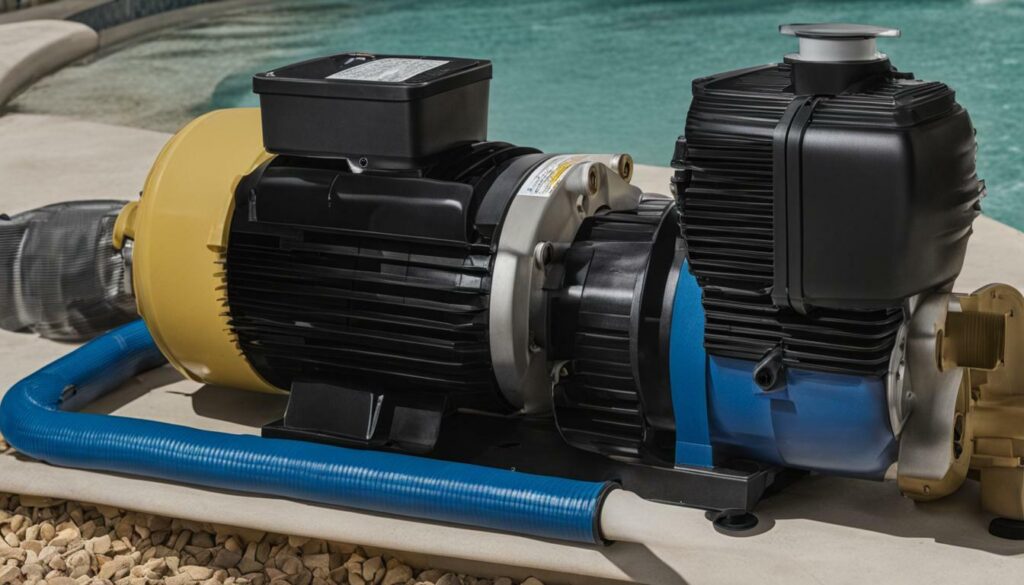
Before starting your pool pump, it’s crucial to prime it properly to ensure optimal performance. Priming the pump involves removing any air pockets and filling the pump with water, which creates the necessary pressure to activate the motor.
To begin priming your pool pump, make sure the pump is fully prepared for start-up, as outlined in section 4. This includes checking the pump’s strainer basket and removing any debris or blockages.
Next, locate the pump’s priming port, which is typically located on the top or side of the pump housing. Remove the priming port’s cap and fill the port with water using a bucket or hose. This water will flow into the pump and push any air pockets through the system.
Continue filling the port with water until you see water flowing steadily from the pump’s discharge port. This indicates that the pump is fully primed and ready for activation.
It’s important to note that if you encounter any difficulties priming your pool pump, such as airlocks or excessive noise, consult the troubleshooting guide in section 10 for potential solutions.

In order to ensure proper functioning of your pool pump, it is important to prime it correctly by removing any air pockets and filling it with water. Follow the steps outlined above to successfully prime your pool pump.
Turning On the Pool Pump
Now that you have primed the pool pump, it’s time to turn it on. Follow these steps to safely and effectively activate your pool pump:
- Locate the on/off switch for the pool pump. This is usually located near the pump or on a nearby wall.
- Ensure the filter valve is set to “filter” mode. This will allow water to flow through the filter and keep your pool clean.
- Turn the on/off switch to the “on” position.
- Listen for the sound of the pump motor turning on. You should hear a soft humming sound.
- Check the pressure gauge on the pump to ensure it is within the normal range. This is typically between 10 and 30 PSI, depending on your pool’s specific requirements.
- Monitor the pool pump for the first few minutes to ensure it is operating correctly and there are no issues. Look for any leaks, unusual sounds, or other signs of trouble.
It is important to keep in mind that the pool pump should not be turned on and off frequently. Doing so can cause unnecessary stress on the pump’s motor and reduce its lifespan. Instead, aim to run the pump for eight to twelve hours a day to keep your pool clean and properly circulated.

Remember, safety should always be a top priority when turning on your pool pump. Before starting the pump, make sure there are no children or pets in the immediate area. Also, be sure to follow all safety guidelines and precautions outlined in your pool pump’s operating instructions.
By following these simple steps and taking the necessary safety precautions, you can safely and effectively turn on your pool pump and keep your pool clean and well-maintained.
Monitoring the Pool Pump
Once the pool pump is up and running, it’s important to keep an eye on its performance. Regular monitoring ensures that your pool stays clean and safe for swimming.
One of the main things to watch out for is the pressure gauge. This gauge displays the pressure inside the pump system and should remain between 10-30 psi. If the pressure is too high or too low, it may indicate a problem that needs attention.
Another important aspect of monitoring your pool pump is listening for unusual sounds. If the pump is making loud or strange noises, it could be a sign of a malfunctioning part or an issue that needs to be addressed.
Similarly, if you notice a decrease in the flow of water from your pool’s jets, it’s time to investigate. A reduction in flow can be caused by a clogged filter or another issue within the pump system.
Regular maintenance is key to keeping your pool and pump in optimal condition. Be sure to follow the manufacturer’s recommended maintenance schedule and perform any necessary tasks promptly. This includes cleaning the pump basket and filter regularly, checking for leaks, and replacing worn parts.
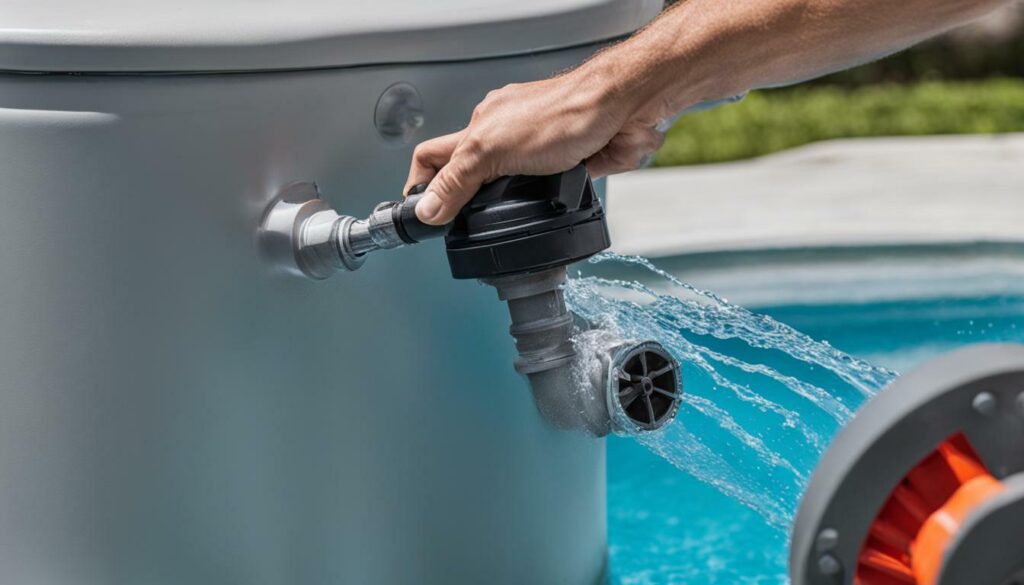
By monitoring your pool pump regularly and performing regular maintenance tasks, you can ensure that it operates efficiently and effectively. So sit back, relax, and enjoy your clean and safe swimming pool!
Adjusting Pool Pump Settings
Once your pool pump is running smoothly, you may need to adjust its settings to ensure optimal performance. The pool pump settings control the speed and run time of the pump, which affects water circulation and filtration in your pool.
To adjust the pump’s settings, locate the control panel on the pump. Most modern pool pumps have digital controls that make adjusting the settings easy and straightforward.
Typically, you’ll need to adjust the following settings:
| Setting | Description |
|---|---|
| Speed | You can choose from different speed options, depending on your pool’s needs. High speed is best for cleaning and vacuuming the pool, while low speed is ideal for regular filtration. |
| Run time | The run time setting determines how long the pump will run each day. You should run the pump long enough to circulate all the water in your pool at least once, usually between 8 and 12 hours. |
| Timer | You can set a timer to turn the pump on and off at specific times of the day, ensuring that the pool is being filtered consistently and efficiently. |
It’s important to note that the optimal pump settings may vary depending on factors such as pool size, water volume, and local climate. Consider consulting with a pool professional to ensure the best settings for your specific pool.
Remember, adjusting the pump’s settings can help maintain crystal clear water in your pool all season long.

Turning Off the Pool Pump
Knowing how to turn off a pool pump correctly is as important as knowing how to turn it on. Proper maintenance and upkeep of the pump extend its life and ensure optimal operation. Here are some essential steps to follow before and during the pool pump shutdown:
- Turn off the power supply: Always start by turning off the pool pump’s power supply. Locate the pool pump’s on/off switch and turn it off. If the pump is hardwired, turn off the breaker in the main electrical panel that controls its power.
- Wait: Allow the pump to cool down before performing any maintenance activities.
- Relieve pressure: Before opening the pump, relieve the pressure inside it. Locate the pressure release valve and turn it counterclockwise to release the pressure.
- Remove debris: Check the pump’s strainer basket and remove any debris or leaves that may have accumulated. This allows the pump to function optimally.
- Inspect the system: Check any attached filters, heaters, or chlorinators for any signs of damage or wear and tear. This helps identify any parts that need repair or replacement during the off-season.
- Clean the pump: The end of the pool season is a good time to clean the pump thoroughly. Use a soft brush and mild detergent to scrub the pump’s housing, impeller, and diffuser. Rinse the pump with water and dry it before storage.
- Store the pump: If you live in an area with extreme winter weather conditions, remove the pump and store it in a dry, sheltered area. Cover the pump with a protective cover to prevent dust and debris from accumulating.
Following these steps will ensure that your pool pump is well-maintained and ready for the next season. Proper pool pump maintenance will help extend its life and reduce the need for costly repairs.

Troubleshooting Pool Pump Issues
Pool pump issues can be frustrating, but don’t panic! With a bit of troubleshooting, you can often resolve the problem quickly and easily. Here’s a pool pump troubleshooting guide to reference when you encounter issues with your pool pump:
No Water Flow
If you’re not seeing any water flow through the pump, the first thing to check is the pool’s water level. If the water level is low, the pump may not be able to function properly. If the water level is okay, you should inspect the pump’s skimmer basket and pool pump basket for debris that may be clogging the flow. In some cases, a clogged impeller or blocked return line could also be the culprit.

If your pool pump is making unusual noises or vibrations, there are several potential causes. The first thing to check is the pump’s motor mount, as this can become loose over time and cause vibration. If the motor mount is secure, inspect the impeller for any damage or debris. In some cases, a faulty bearing could also be the problem.
Low Pressure
A drop in pressure may be caused by a dirty filter or skimmer basket. Clean or replace the filter and check the skimmer basket for debris. If these steps don’t resolve the issue, there may be a problem with the impeller or pump basket, which could be causing a blockage.
Leaks
Leaks are typically caused by a damaged o-ring, gasket, or seal. If you notice water leaking from your pool pump, inspect these components for any damage. In some cases, a cracked housing or loose fitting may also be the cause of a leak.
Remember to always use caution when attempting to troubleshoot your pool pump. If you’re unsure of what to do, it’s best to consult a professional. Regular maintenance and inspection of your pool pump can go a long way in preventing unexpected issues from arising.
Conclusion
Knowing how to start and maintain your pool pump is crucial for a safe and healthy pool environment. By following the step-by-step guide and troubleshooting tips provided in this article, you can ensure that your pool pump operates efficiently and effectively. Remember to always prioritize pool pump safety and regularly monitor its performance.
Pool Pump Troubleshooting
If you encounter any issues with your pool pump, don’t panic! Use the troubleshooting guide provided in this article to identify and resolve common problems that may arise. Some troubleshooting tips include checking for clogs or debris in the pump, ensuring the pool water level is adequate, and examining the pump’s motor and wiring. If you are still experiencing issues, consider seeking professional assistance from a pool maintenance company.
Pool Pump Start-up
Starting your pool pump correctly is essential for its longevity and optimal performance. Remember to always prepare and prime the pump before turning it on. Monitor the pump’s performance regularly and adjust its settings as needed to maintain proper water circulation and filtration. When it’s time to shut down the pump, perform any necessary maintenance tasks to ensure its continued functionality. By following these guidelines and prioritizing pool pump safety, you can enjoy a clean and healthy pool all summer long!
FAQ
Q: How do I turn on my pool pump?
A: To turn on your pool pump, locate the on/off switch and flip it to the “on” position. Ensure that the pump is properly primed and that all safety measures are in place before activating the pump.
Q: What are the components of a pool pump?
A: A pool pump typically consists of an on/off switch, a motor, a pump basket, impeller, and a filter. These components work together to circulate and filter the water in your pool.
Q: How can I troubleshoot my pool pump?
A: If you’re experiencing issues with your pool pump, first check for any clogs or debris in the pump basket or filter. Ensure that the pump is properly primed and that there are no leaks or loose connections. If problems persist, consult a professional for further assistance.
Q: What maintenance tasks should I perform on my pool pump?
A: Regular maintenance tasks for your pool pump include cleaning the pump basket, checking and cleaning the filter, inspecting for any leaks, and ensuring that all connections are secure. It’s also important to monitor the pump’s performance and address any issues promptly.
Q: How do I prime my pool pump?
A: To prime your pool pump, start by turning off the pump and closing any valves connected to the pump. Fill the pump basket with water until it overflows into the pump housing. Once the pump housing is full of water, turn the pump back on and it should start priming.
Q: How do I adjust the settings on my pool pump?
A: The specific settings on your pool pump will depend on your pool’s requirements. Typically, you’ll need to adjust the pump’s speed, timer, and flow rate. Consult your pump’s manual or a professional for guidance on adjusting these settings.
Q: How do I shut down my pool pump?
A: To safely shut down your pool pump, locate the on/off switch and flip it to the “off” position. Allow the pump to run for a few minutes to ensure all water is cleared from the system. Perform any necessary maintenance tasks, such as cleaning the pump basket, before turning off the pump completely.
Q: What should I do if I’m having issues with my pool pump?
A: If you’re experiencing problems with your pool pump, refer to the troubleshooting guide in this article. Check for common issues such as clogs, leaks, or inadequate priming. If problems persist, consult a professional for further assistance.


